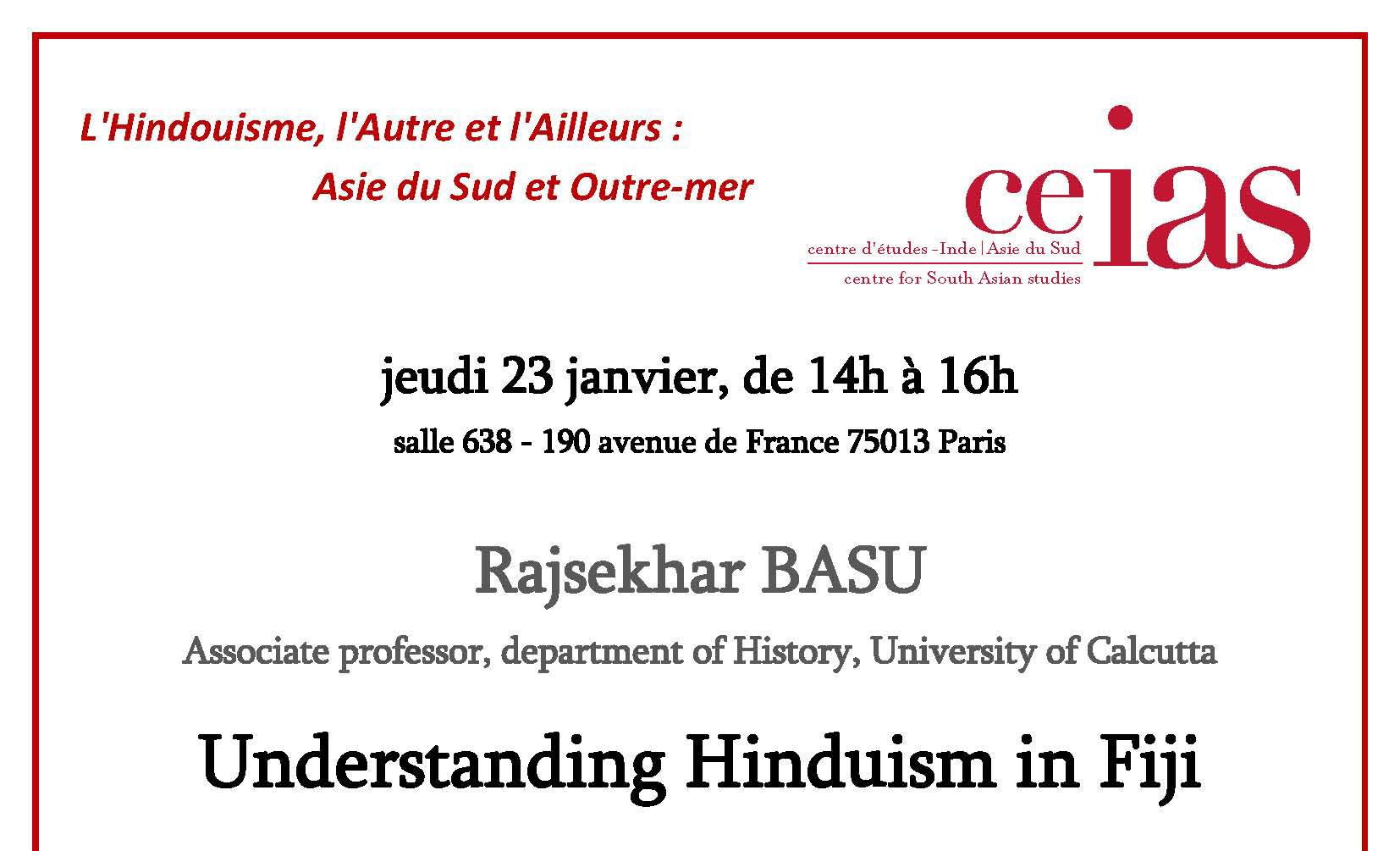Vie scientifique | Séminaires / Conférences
Understanding Hinduism in Fiji
L'Hindouisme, l'Autre et l'Ailleurs : Asie du Sud et Outre-mer
[salle 638 - 190 avenue de France 75013 Paris]
Rajsekhar BASU
(Associate professor, department of History, University of Calcutta)
In this presentation, Rajsekhar Basu will build a narrative that would transcend the repeated views on the ways Hinduism evolves in alien surroundings. The point that needs to be addressed while discussing Hinduism in Fiji is whether this sort of emotional attachment to a religious tradition has to be viewed in terms of a connectivity to an existing homeland or an imagined past.
Hindus in Fiji are not one, since they are divided in terms of their caste composition and geographical places of origin and the place of their settlement in the colony. Rajsekhar Basu is more concerned with the idea of what actually it meant to a girmitya (indentured laborer) to be a Hindu and how it finds its way to their present day descendants, who continue to share a sense of emotive attachment to the Bhojpuri speaking tracts of eastern and northern India and to the Tamil speaking tracts of erstwhile Madras Presidency. Nonetheless, the free mixing between castes, both in ships and the plantation barracks were largely responsible for the reasons behind the failure of a small number of Brahmins to create a social space for the preservation of the Brahmanical cultural traditions.
Possibly, this encourages an investigation into the complexities of the Indo Fijian Hindu identity, which has been born out of a whole range of experiences ranging from "brothers/sisters of the ship", Arya Samajist interventions, Sanatani Hinduism and the cultural interactions between Islam and Christianity.
By the 1970s, when Fiji gained her independence, the loose Hindu identity, largely based on the folk/ local traditions were being replaced by a form of Brahminised Sanatani Hinduism, whereby social boundaries along the lines of jati ranking were being constructed and the loss of one’s jati identity in a historical past was sought to be negotiated in favour of a more respectable social status, mediated through a language of authority and power justifying the claims of Hinduism and its importance in matters of political representation.
Discussant : Catherine Servan-Schreiber (CEIAS)
Les sites du CEIAS
- SAMAJ | The South Asia Multidisciplinary Academic Journal
- CEIAS - Facebook
- CEIAS - Twitter
- CEIAS - Newsletter
- Le Bulletin de la Bibliothèque
- Régionalisme & cosmopolitisme
- DELI | Dictionnaire Encyclopédique des Littératures de l’Inde
- DHARMA | The Domestication of “Hindu” Asceticism and the Religious Making of South and Southeast Asia
- TST | Texts Surrounding Texts
- STARS | Studies in Tamil Studio Archives and Society 1880-1980
- I-SHARE | The Indian Subcontinent’s Shared Sacred Sites
- Sri Lanka et diasporas
- Sindhi Studies Group
- Carnet du Master Études asiatiques
- Master “Asian Studies”
- Social Sciences Winter School in Pondicherry
- Caste, Land and Custom
- Musiques indiennes en terres créoles
 Actualités
Actualités
Devenir juifs : conversions et assertions identitaires en Inde et au Pakistan
 Débat - Mardi 9 mai 2023 - 14:00Présentation« L’an prochain à Jérusalem ! », scande un homme portant une kippa dans une synagogue de Karachi au Pakistan. Ses paroles sont répétées en chœur par les membres de sa communauté, un groupe comptant près de trois cents personnes qui s’autodésignent par (...)(...)
Débat - Mardi 9 mai 2023 - 14:00Présentation« L’an prochain à Jérusalem ! », scande un homme portant une kippa dans une synagogue de Karachi au Pakistan. Ses paroles sont répétées en chœur par les membres de sa communauté, un groupe comptant près de trois cents personnes qui s’autodésignent par (...)(...)
Le Centre d'études sud-asiatiques et himalayennes (Cesah), nouveau laboratoire de recherche (EHESS/CNRS) sur le Campus Condorcet
Échos de la recherche -Depuis le 1er janvier 2023, l'EHESS, en tant que co-tutelle, compte un nouveau centre de recherche né de la fusion du Centre d'études de l'Inde et de l'Asie du Sud (CEIAS - EHESS/CNRS) et du Centre d’études himalayennes (CEH - CNRS) : le Centre d'études sud-asiatiques et h (...)(...)
Centre d'Études de l'Inde et de l'Asie du Sud
UMR8564 - CNRS / EHESS
54 boulevard Raspail
75006 Paris, France
Tél. : +33 (0)1 49 54 83 94
Communication :
nadia.guerguadj[at]ehess.fr
Direction :
dir.ceias[at]ehess.fr
La bibliothèque du CEIAS
Maison de l'Asie
22 avenue du Président Wilson 75016 Paris
54 boulevard Raspail
purushartha[at]ehess.fr



